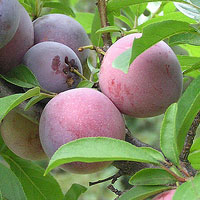Burbank Plum (Prunus salicina)
Category: Fruit & Nut Trees

The Burbank plum is a hardy plum tree native to Japan. It is a tree that bears early and has heavy crops that can be used for home orchard as well as commercial.
A normal tree grows up to 35m in height and spreads at 20m whereas a dwarf grows up o 10’ in height spreading at the same level.
The tree adapts to a variety of growing conditions. It needs full sun and enough moisture for better growth. The soils should be non-alkaline, sandy loam soils with good drainage. Heavy rains and high humidity when the tree is growing is not very good because it reduces production by causing fruit cracking and attracting diseases.
The leaves are simple, alternate, and elliptic with acute tips. They are finely toothed at the margins and folded up-ward along the midrib. On top they are bright green but light colored beneath. Sometimes they have or don’t have fine hairs.
The foliage is bright green in color. The flowers bloom early in the spring making them susceptible to late frost. They are white in color and have five oval petals in umbrella-like clusters of 2-3 on short spurs.
Pruning of the tree should be done when the tree is still young where dead, damaged and diseased wood should be removed. When the tree matures, upright shoots are removed because as fruits increase they tend to occur on older woods. Plums need minimal pruning and this should be done during flowering time when the tree is still leafless.
Fruiting begins in 2-4 years after the tree is planted. The skin of the plum is normally red-purple with a yellow blush. The amber is fresh, firm, sweet and juicy. The ripening of the fruits takes place around July to August. It is good the fruit to be picked before it fully ripens and left to ripen slowly

 Back To Category Fruit & Nut Trees
Back To Category Fruit & Nut Trees